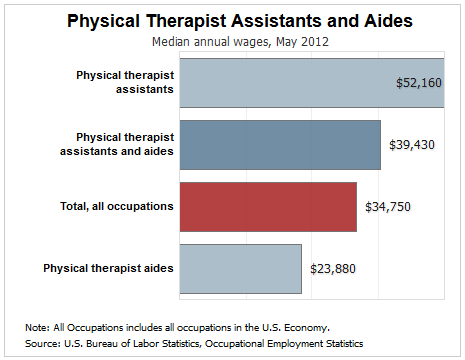 Physical therapy is the healing profession. Patients undergo this therapeutic treatment when they are recovering from injury, illness, or surgery. The role of the physical therapy assistant is to bring their patient's bodies into better function, enabling them to resume their lives as mobile, healthy, and as pain-free as possible.
Physical therapy is the healing profession. Patients undergo this therapeutic treatment when they are recovering from injury, illness, or surgery. The role of the physical therapy assistant is to bring their patient's bodies into better function, enabling them to resume their lives as mobile, healthy, and as pain-free as possible.
The physical therapy assistant will often be highly trained in the skeletal, muscular, neurological, respiratory, and circulatory systems of the body. They are generally very knowledgeable in the benefits of physical exercise and skilled at developing individualized treatment programs designed around a specific body weakness. This challenging role assists the licensed physical therapist in promoting healing, helping patients grow stronger by building their flexibility and ultimately, their independence.
Physical therapy assisting can take the form of exercise and functional activities designed to rehabilitate and restore, potentially reducing the need for long-term prescription medications. The PTA teaches patients how to manage their condition – and prevent further injury.
Treatment modalities can include electrical muscle stimulation, heat and cold packs, and massage. The physical therapy assistant also helps patients in walking with assisted devices such as crutches. This treatment occurs in a variety of settings including hospitals, private practices and outpatient treatment facilities, sports and fitness businesses, at work and in nursing homes.
Educational Requirements to Become a PTA
While physical therapists are well-educated, licensed health care providers who receive graduate level education from an accredited program, and then take a licensure exam, the PTA role requires half the educational commitment with expansive career opportunities.
For the career-minded professional that wants to help patients heal, there could be as little as 18 months of instruction to earn a physical therapy assistant degree. PTAs work under a licensed physical therapist as part of a rehabilitative team of health care providers. Physical therapy assistants facilitate many of the same treatments as the PTs themselves, and in many of the same settings.
Each day in the United States, physical therapists, with the help of physical therapist assistants, diagnose and treat more than 750,000 patients, according to the American Physical Therapy Association. Their work includes:
- Managing physical functioning and movement
- Preventing further injury by teaching and facilitating proactive treatment of muscular and other physical impairments
- Improving fitness
- Restoring quality of life
Generally speaking, the PTA is expert in movement, using carefully crafted exercises to rehabilitate and strengthen their patients. Making the decision to pursue either career path will require considerable financial and time commitment, but the job market is booming, making this well worth the effort. In fact, most PTA degrees can be achieved in two years or less!
Career Outlook & Salary for Physical Therapist Assistants
The career outlook for the PTA is very positive, particularly in light of expected expansion of health care treatment for the aging baby boomer population in the next few years.
 According to the Bureau of Labor Statistics, demand for the graduating PTA is exploding and they will enjoy a great deal of job security over the next 10 years. It’s been predicted that the demand for qualified physical therapy assistants is going to increase by as much as 41% by 2018.
According to the Bureau of Labor Statistics, demand for the graduating PTA is exploding and they will enjoy a great deal of job security over the next 10 years. It’s been predicted that the demand for qualified physical therapy assistants is going to increase by as much as 41% by 2018.
According to the BLS, the median income of a physical therapy assistant is $52,160 annually. These health care professionals can choose from a wide range of work settings, from a hospital to a clinic. Physical therapy is a valuable part of a patient’s treatment plan, with many orthopedic surgeries requiring PT as part of a successful recovery.
What Makes a Good Physical Therapy Assistant?
The best physical therapists are compassionate healers. To become a PTA, you’ll need good problem solving skills, patience and flexibility. You must enjoy working with people and be patient with an individual’s ability to tolerate pain and adapt to physical disabilities or limitations. You must also be able to move and be in decent shape; physical therapy assistants are on their feet for long hours and must be able to physically assist patients when needed.
This is a very rewarding field. Physical therapy assistants literally can help human beings walk again, help them manage their pain, and teach them proactive coping skills to overcome debilitating injuries.
21.6 percent of these health care providers are engaged in small business with licensed physical therapists who are also entrepreneurs, partners or owners of their own private PT practice.
So blessed to say I just got the best phone call to end my summer. I am proud to be 1 of the 16 that was accepted into the PTA program @ECPI
— Elizabeth Cobb (@Cobbe_) August 18, 2014
Become a Physical Therapist Assistant -- The Healing Professionals
If you’re looking for a career as a PTA, look no further than ECPI University.
At ECPI University’s School of Health Science, Medical Careers Institute (MCI), you could earn an Associate of Applied Science Degree in Physical Therapist Assisting in less than two years. Contact us today to get started! It could be the Best Decision You Ever Make!
DISCLAIMER – ECPI University makes no claim, warranty or guarantee as to actual employability or earning potential to current, past or future students or graduates of any educational program we offer. The ECPI University website is published for informational purposes only. Every effort is made to ensure the accuracy of information contained on the ECPI.edu domain; however, no warranty of accuracy is made. No contractual rights, either expressed or implied, are created by its content.
Gainful Employment Information
For more information about ECPI University or any of our programs click here: http://www.ecpi.edu/ or http://ow.ly/Ca1ya.


